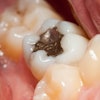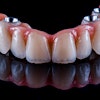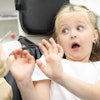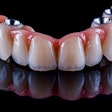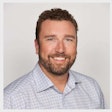
At day's end on September 11, 2001, one of the things that struck Jeffrey Dongieux, DDS, was the eerie silence of New York's normally bustling streets.
Then an oral and maxillofacial surgical resident at the New York University (NYU) Medical Center, Dr. Dongieux was at the NYU College of Dentistry setting up program cases when he heard the news.
"My program director grabbed me and said a plane had hit the World Trade Center," he told DrBicuspid.com as he recalled the horrors of the terrorist attacks.
Dr. Dongieux, who grew up in New Orleans, received his dental degree at the Louisiana State University School of Dentistry in New Orleans. In 2001, he was a fourth-year surgical resident at NYU's Medical Center and was one of two chief residents at Bellevue Hospital, the teaching hospital for NYU.
Today he is an oral and maxillofacial surgeon with a private practice in Kenner, LA. He also sees patients at the Louisiana Dental Center, which has locations in the Baton Rouge and New Orleans areas.
Treating facial traumas
On the morning of 9/11, Dr. Dongieux and other medical residents wrote on the scrubs they were wearing what their level of training was and their specialty, so they could be assigned to different stations.
 Dr. Jeffrey Dongieux was an oral and maxillofacial surgical resident at New York University Medical Center on September 11, 2001.
Dr. Jeffrey Dongieux was an oral and maxillofacial surgical resident at New York University Medical Center on September 11, 2001.
"Instead of having to figure out if you're a plastic surgery resident or ENT, they knew that people with our training could treat facial injuries and facial lacerations, and then they would assign you to certain areas," he said. "I had written on mine, "chief resident, oral and maxillofacial surgery,' so they assigned me to the suture room which was what we normally handled at the hospital treating facial trauma."
At first, most of the patients coming to the emergency room were burn victims, people who had been waiting for an elevator in the lobby of one of the Twin Towers when a fireball flamed down the elevator shaft and blew out the elevator doors, he said.
Some were beyond treatment.
"One of the things they didn't talk about a lot were the number of people who were actually killed by people who were jumping," Dr. Dongieux noted. "There were one or two firefighters brought in who were dead on arrival, killed by people who had jumped."
Sitting and waiting in the ambulance bays at Bellevue, he could see and hear fighter jets screaming overhead, about 100 feet off the ground and over the East River.
"F-15 jets were flying around the city doing reconnaissance to ensure that no other planes were coming," Dr. Dongieux recalled.
He then heard a radio transmission, and one of the policemen saying, "'One of the towers came down,'" Dr. Dongieux said. "I asked, "What do you mean? How could it fall? Is it leaning?' "
"No, it just collapsed," the police officer said.
Surreal street scenes
Dr. Dongieux eventually got a ride to ground zero. As he neared the World Trade Center, he saw surreal street scenes.
“I think it’s our generation’s Pearl Harbor.”
— Jeffrey Dongieux, DDS
"When I arrived at the site, on one of the side streets, one of the first things I saw was one of the plane tires and part of the landing gear in the middle of the street," he remembered.
As he got closer to the Twin Towers, he sometimes walked over steel planks thrown down by the collapsing buildings that were serving as makeshift walkways.
Beyond the planks, he saw a deep, smoking cavern -- the devastated floors of shops and parking garages below the Twin Towers of the World Trade Center.
"We were walking on these planks and there were fires that were burning underground, so we walked on these steel planks through ground zero to the Millenium Hilton hotel, where we ended up treating victims that first night," Dr. Dongieux said. "These planks were really, really hot. They melted the bottoms of my shoes."
 At ground zero, Dr. Dongieux was assigned a special emergency identification badge.
At ground zero, Dr. Dongieux was assigned a special emergency identification badge.
At ground zero, he was assigned a special emergency identification badge.
"We had to show our medical badges, and we gave them our Social Security numbers, which they laminated with an ID number in case something happened to us," Dr. Dongieux explained.
Across from the towers, the Millenium Hilton hotel had been turned into a trauma center, where Dr. Dongieux mostly irrigated the eyes of firefighters and put in sutures.
The scene was total devastation, he recalled.
"There was a Border's bookstore and they were hosing it down, and you could see all the magazines and books, all the windows were blown out. There was wreckage everywhere," Dr. Dongieux remembered. "There was a police car with all the windows blown out, the alarm flashing. Firefighters had alarms that would go off if they were in distress, and you could hear these alarms going off everywhere. It was firefighters who were either dead or trapped in the rubble."
Despite the number of offices and equipment in the Twin Towers, little left was recognizable.
"There was paper everywhere, but you would think with an office building you'd see chairs or tables, something, but it was nothing but ash and paper," he described. "It reminded me of Mount St. Helens because of the ash and soot in the air. You can still see a couple inches of soot and ash on my shoes and scrubs that I saved."
Dr. Dongieux kept many of the items issued to him for his volunteer work in the aftermath of 9/11 in display cases in his office. He hopes the mementos will help his children better understand what happened that day, he said.
"I think it's our generation's Pearl Harbor," Dr. Dongieux said.
 Dr. Dongieux hopes the mementos he kept from 9/11 will help his children better understand what happened that day.
Dr. Dongieux hopes the mementos he kept from 9/11 will help his children better understand what happened that day.
Right thing to do
In the days that followed, Dr. Dongieux would walk into Bellevue for his regular hospital duties, alongside what came to be known as the Wall of Prayer, a plywood wall lining a construction area for a future expansion of the hospital.
There people had posted pictures and identifying information about missing loved ones, he said.
About a week after the attack, Dr. Dongieux was called to return to ground zero to examine a firefighter who had been hit in the face by a piece of steel.
At one point he found himself in charge of a 7-Eleven store that had been turned into a triage center when the neurosurgeon in charge had to leave for an emergency case.
"He just came to me and said, "Hey, you need to take over. I gotta go,' and I said, "Well, OK."
Dr. Dongieux and a fellow resident who had come with him to ground zero stayed there through the night, then he passed off his duty to another doctor who came in the next morning.
"I don't consider what I did a heroic thing," Dr. Dongieux said simply. "I just happened to be in New York."
